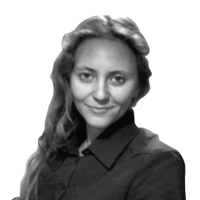LVIV, Ukraine — Ostap Stakhiv, the leader of a political organization of Ukrainian nationalists, The Idea of the Nation, had been looking for popular support for many years without much success. Then the delicate-seeming 28-year-old started thinking that maybe there was something wrong with the insignia—a lion climbing up a steep hillside—printed on the group’s tracts and fliers. So Stakhiv chose another: the swastika, slightly modified, that Hitler adopted as the emblem of the Nazi Party in 1920 and that millions of Europeans, including millions of Ukrainians, associate with death.
It worked. Earlier this week, Stakhiv was busy setting up five tents around Lviv for this month's election campaign. He’s preparing to run for the local parliament on October 26th. The organization's newspaper, with double swastikas on the front page, was being distributed along with other propaganda materials, and Stakhiv and his aid, Yulia, marveled at the strength of the symbol. "A yellow swastika on a black field stands for power and spirit," said Stakhiv.
It also stands for just about everything negative that Russian President Vladimir Putin preaches about Ukraine being taken over by crypto-, and not-so-crypto-, Nazis. But young Stakhiv insists that’s wrong. He says he’s campaigning in opposition to "oligarchs running the country, the actual enemy of Ukraine" and sees his mission as opposing the politics of the current president, the billionaire Petro Poroshenko, who, Stakhiv claims, does not see the real picture.
"The swastika is a very strong symbol, and as soon as we adopted it, we immediately grew popular among young people,” said Stakhiv. “Those who join us know exactly what they want, and they are ready to go to the very end." Today, Idea of the Nation is represented in 14 regions of Ukraine and counts over 1,000 activists, its leader told The Daily Beast.
How to explain the growing popularity of Nazi symbols in Ukraine? They keep turning up. Ukrainian soldiers have been seen and photographed wearing helmets with swastikas and the letters SS on their helmets.
A spokesmen for the volunteer Azov Battalion, where the symbols are common, eventually denied they are related to Hitler. He insisted that the battalion insignia reminiscent of the Nazi Wolfsangel, symbol of, among others, the 2nd SS Panzer Division that fought the Russians on the Eastern Front, was actually nothing but the crossed letters "N."
In fact, most nationalist and ultra-right youth organizations in Ukraine today use symbols that millions of Ukrainian citizens associate with the Nazi army that occupied and brutalized Ukraine during World War II. And one reason, certainly, is that the much longer and very deadly occupation by the Soviets is also a huge part of the national consciousness. The 1933-34 famine known as the Holodomor—“extermination by hunger”—took the lives of some 4 million people.
On Monday night, a few dozen revolutionary nationalists from another movement, Autonomous Resistance, marched around the streets of Lviv with the red and black flags of the Ukrainian Insurgent Army, or UIA. These were Ukrainian rebels fighting in the woods of western Ukraine, sometimes in alliance with Nazi forces against Soviet soldiers and sometimes against the German army occupying Ukraine.
The activists chanted "Freedom to the people! Glory to Ukraine!" on the way to the monument in Lviv to Stepan Bandera, the UIA leader. To millions of ethnic Russians living in eastern Ukraine, Bandera, who allied himself with Adolf Hitler at times, symbolized ethnic cleansing in the worst years of the Second World War. But to many nationalists he is a hero who tried to protect the interests of his people.
"Just as our grandfathers demanded freedom for Ukraine from foreign empires we demand freedom from Russian occupiers today," said one of the movement's leaders, Yarina Voloshin, wearing a red dress and carrying a black purse.
On the same day, thousands of nationalists marched to Ukraine's parliament in Kiev, led by ultra-right Svoboda party leaders. The nationalists, who clashed with police, demanded the UIA be recognized as Ukraine's national heroes. Dozens of people, including 15 policemen, were injured in those melees, and police detained 50 nationalists who tried to break through rows of security to get into the parliament.
Earlier this week Putin referred to the UIA as a "pro-fascist organization" and condemned Ukraine for glorifying it. Putin also blamed Ukrainian nationalists for attacking the Orthodox Church of the Moscow Patriarchate in Ukraine. "Regrettably, the vaccine against the virus of Nazism produced at the Nuremberg tribunal is losing its original strength in some European countries," Putin told the Serbian daily Politika.
But in Lviv, which is considered the heart of the country's nationalist movements, legislators and the local administration insist the Nazi symbols are not dangerous for the country. "I don't care what flags or symbols they use for as long as they fight for Ukraine's freedom," Vice Governor Vladimir Kharchuk told The Daily Beast. To people in western Ukraine, where thousands related to victims of communist repression, the hammer and sickle did not look any less evil than the swastika, yet several organizations still had that insignia on their official documents. "I personally prefer the Ukrainian official flag, and the emblem of Lviv—a kind looking lion—to a Swastika."
But as others have discovered in these times of enormous passions, kindly symbols don’t attract crowds.






